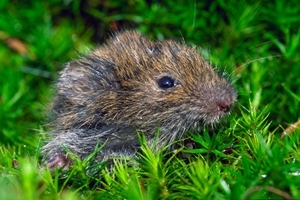 Some moorland managers are reporting a significant fall in vole numbers. In some cases, they are suggesting a complete absence of voles – what is going on?
Some moorland managers are reporting a significant fall in vole numbers. In some cases, they are suggesting a complete absence of voles – what is going on?
The common vole (Microtus arvalis) doesn’t occur in Britain, though it can occur in large numbers in the arable fields of continental Europe (Anderson et al. 2009; Koks et al. 2007; Salamolard et al. 2000).
It is possible that this is why arable land in Britain is not attractive to hen harriers; it would not provide sufficient food for breeding, although there have been two recent records of this species breeding in arable areas of southern England, in 2003 and 2009.
However, field voles (Microtus agrestis) are found throughout mainland Britain1. These voles typically occur in ungrazed grassland or in the early stages of forestry plantations but may also live in woodland, hedgerows, dunes, scree or moorland, wherever grass is available.
In extensive grasslands, field vole populations may fluctuate on a four-year cycle, with numbers increasing tenfold between the lows and highs. We certainly seemed to find at Langholm Moor that the vole population there has a three/four-year cycle, matching as it does the Kielder Forest (the centre of which is only 10km to the east of Langholm Moor) vole cycle.
It last peaked in 2014 and this year there do indeed appear to be few voles around. Other moors that have the same cycle may be having a particularly low vole year in 2016. Why voles cycle is still a matter of research, but the interaction of vole diseases, vole movement and the disruptive effect of large areas of habitat unsuitable for voles may appear to be implicated.
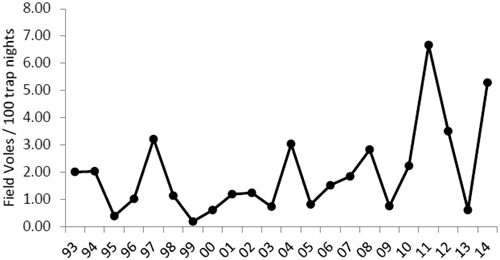
Number of voles trapped at Langholm in spring (per 100 trap nights). Note that in
2001 data were collected six weeks later than usual due to foot and mouth disease.
[Langholm Moor Demonstration Project, Seven Year Review – December 2014]
There are also interesting relationships between voles and the wide range of species that predate them. Whilst mammals such as foxes, weasels and stoats do take voles, it is the bird species such as kestrels and owls that are fascinating.
The number of young reared by kestrels and owls has been shown to increase when vole numbers increase. This relationship was also found with hen harrier fledging success at Langholm (1994-2000).
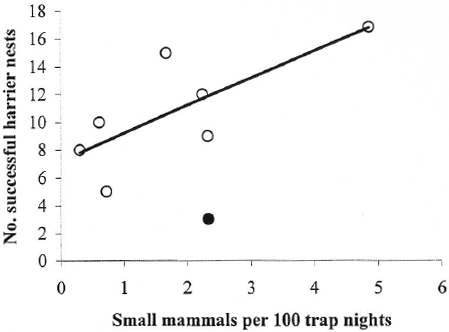
Relationship between number of harrier nests that successfully fledged chicks on Langholm
Moor from 1994-2001. The number of small mammals caught each spring per 100 trap
nights. Line is linear regression for years 1994-2000. Black circle represents data for
2001. [Hen Harrier and Red Grouse population monitoring at Langholm, 2001]
In many parts of their range, the settling density and clutch size of hen harriers appears strongly influenced by the abundance of voles2 (Redpath et al 2002).
Hen harriers retreated to the Orkney Islands in the early part of the 20th Century, and survived partly because of lower rates of illegal killing and partly because the Orkney vole (Microtus arvalis orcadensis) is abundant and larger than the field vole, providing better feeding opportunities. Later in a breeding season, harriers can switch their hunting patterns to search for red grouse chicks as grouse densities increase (Redpath & Thirgood 1999).
The vole breeding season begins in March/April and they normally have five or six litters each year with four or five young in each litter. So in high vole population years this early abundance of food may also influence nesting site selection as hen harriers return from over-wintering roost locations.
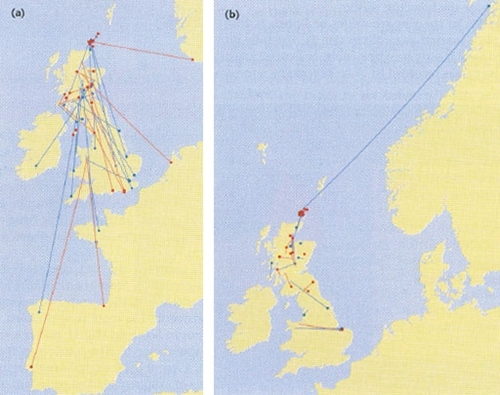
Locations in autumn (red) and winter (blue) and movements of over 20km
between breeding season and autumn or winter male (a) and female (b) hen harriers
present in Britain and Ireland during the breeding season. [The Migration Atlas,
movements of the birds of Britain and Ireland, 2002]
Hen harrier immigration to England, and to moors such as Langholm, is most likely to have come from north, west and central Scotland. This immigration is the most likely explanation of the rapid growth of hen harrier numbers since 2013 and may explain how hen harrier breeding numbers were able to jump back up.
It seems probable that the increase in Scottish hen harrier breeding and recruitment from the 1970s to present has allowed this emigration. One of the drivers for the increase in harrier numbers in Scotland was certainly the loss of heather moorland, first to forestry planting and then to rough grass, as sheep flocks declined across the uplands.
More recently, forest canopies have closed and in some places previously rough grass, good for voles, has been replaced with improved grass, better for sheep and cows as farmers have attempted to stay on the land. However, the landscape-scale effects of these changes have not been measured.
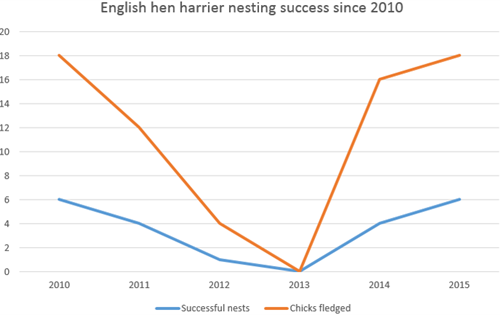
Most of us can move through our countryside without even noticing the estimated 75 million field voles out there – but their predators do. The tiny field vole, which has been present since before the end of the last glaciation, 11,000 years ago, continues to influence where species, such as the hen harrier, decide to nest.
Photo credit: Photo by Fer Boei / CC BY-SA 3.0
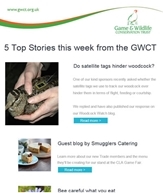 Free weekly newsletter
Free weekly newsletter
Stay updated and get all the latest GWCT blog updates and news delivered straight to your inbox each week.
Sign up FREE to the Weekly GWCT Newsletter >
Notes
1 They are absent from a number of islands including Shetland, the Isle of Man, Isles of Scilly, Lundy and Ireland and replaced by larger Orkney and Guernsey voles on the respective islands.
2 It is also worth noting that whilst there are no voles on the Isle of Man, harriers still settle there in numbers. This is probably responding to meadow pipit (Anthus pratensis) numbers.